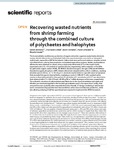Mostrar o rexistro simple do ítem
Recovering Wasted Nutrients From Shrimp Farming Through the Combined Culture of Polychaetes and Halophytes
| dc.contributor.author | Jerónimo, Daniel | |
| dc.contributor.author | Lillebø, Ana Isabel | |
| dc.contributor.author | Cremades, Javier | |
| dc.contributor.author | Cartaxana, Paulo | |
| dc.contributor.author | Calado, Ricardo | |
| dc.date.accessioned | 2021-04-29T15:51:40Z | |
| dc.date.available | 2021-04-29T15:51:40Z | |
| dc.date.issued | 2021-03-23 | |
| dc.identifier.citation | Jerónimo, D., Lillebø, A.I., Cremades, J. et al. Recovering wasted nutrients from shrimp farming through the combined culture of polychaetes and halophytes. Sci Rep 11, 6587 (2021). https://doi.org/10.1038/s41598-021-85922-y | es_ES |
| dc.identifier.issn | 2045-2322 | |
| dc.identifier.uri | http://hdl.handle.net/2183/27859 | |
| dc.description.abstract | [Abstract] The bioremediation and biomass production of organic extractive organisms (polychaetes Arenicola marina, Hediste diversicolor and halophyte Salicornia ramosissima) was assessed in an integrated multi-trophic aquaculture (IMTA) framework. Culture trials were performed outdoors using the nutient rich effluent from a shrimp farm employing recirculated aquaculture systems. Similar bioremediation efficiencies were obtained in cultures using a single polyculture tank (1 T) or two trophic levels separated tanks (2 T; ≈ 0.3 and 0.6 m2 operational area, respectively), with a reduction of 74–87% for particulate organic matter (POM), 56–64% for dissolved inorganic nitrogen (DIN) and 60–65% for dissolved inorganic phosphorus (DIP). Hediste diversicolor adapted well to culture conditions, reaching densities up to 5.000 ind. m−2 (≈ 78–98 g m−2). Arenicola marina failed to cope with water temperature that exceeded the species thermal limits, displaying a survival < 10% (20 °C often pointed as the maximum thermal threshold for this species). Productivity of S. ramosissima with 1 T was about twice that obtained with 2 T (≈ 150–170 and ≈ 60–90 g FW m−2 edible aboveground biomass, respectively). The yellowish coloration of cultured plants was likely due to the chemical oxidation and rapid sand filtration pre-treatment applied to the brackish groundwater used in the aquaculture facility, that removed iron (and probably other essential elements). Overall, 1 T design combining H. diversicolor and S. ramosissima displayed the best bioremediation performance and biomass production, while also allowing reducing in half the operational area required to implement this IMTA framework. | es_ES |
| dc.description.sponsorship | European Commission; 24517, 10/SI/2016 | es_ES |
| dc.description.sponsorship | European Commission; MAR-02.01.01-FEAMP-0038 | es_ES |
| dc.description.sponsorship | European Commission; Centro-01-0145-FEDER-000018 | es_ES |
| dc.description.sponsorship | Fundação para a Ciência e a Tecnologia (Portugal); PD/BD/127989/2016 | es_ES |
| dc.description.sponsorship | Fundação para a Ciência e a Tecnologia (Portugal); CEECIND/01434/2018 | es_ES |
| dc.description.sponsorship | Fundação para a Ciência e a Tecnologia (Portugal); UIDP/50017/2020+UIDB/50017/2020 | es_ES |
| dc.language.iso | eng | es_ES |
| dc.publisher | Springer Nature | es_ES |
| dc.relation.uri | https://doi.org/10.1038/s41598-021-85922-y | es_ES |
| dc.rights | Atribución 4.0 Internacional | es_ES |
| dc.rights.uri | http://creativecommons.org/licenses/by/4.0/ | * |
| dc.subject | Environmental biotechnology | |
| dc.subject | Field trials | |
| dc.subject | Marine biology | |
| dc.subject | Sustainability | |
| dc.title | Recovering Wasted Nutrients From Shrimp Farming Through the Combined Culture of Polychaetes and Halophytes | es_ES |
| dc.type | info:eu-repo/semantics/article | es_ES |
| dc.rights.access | info:eu-repo/semantics/openAccess | es_ES |
| UDC.journalTitle | Scientific Reports | es_ES |
| UDC.volume | 11 | es_ES |
| UDC.startPage | 6587 | es_ES |
| dc.identifier.doi | 10.1038/s41598-021-85922-y |






